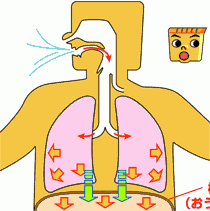Pelvic floor rehabilitation is a systematic approach for improving strength of the pelvic muscles. These muscles may be damaged due to childbirth, prior surgery, aging, and several other factors. Many postpartum mothers reported that after the pelvic floor muscle assessment, the pelvic floor EMG report showed that the before and after resting values were out of the reference range, and there were symptoms of pelvic floor pain and cramps, especially after pelvic floor muscle training. At this time, the doctor will guide the mother to change the breathing method, from shallow and fast chest breathing to deep and slow abdominal breathing.
The air pressure difference of human breathing is realized by the volume change of the cavity. Therefore, there are two breathing methods in muscle exercise, namely chest breathing method and abdominal breathing method.
Chest breathing usually uses intercostal muscles to draw air into the chest cavity. In upper lobe breathing or clavicle breathing, air is sucked into the chest mainly by raising the shoulders and collarbone and simultaneously contracting the abdomen during inhalation.
Abdominal breathing, commonly known as deep breathing, is a breathing method in which the diaphragm is contracted to contract the muscles between the chest cavity and the abdominal cavity in a nearly horizontal state. The transversus abdominis drives the diaphragm downwards, squeezes the abdominal organs, increases intra-abdominal pressure, and makes the abdomen bulge. When we breathe, we see the protrusion of the upper abdomen, which is actually caused by the depression of the diaphragm. (Source: Wikipedia)

The muscles used for abdominal breathing are our narrowly defined core muscles, namely the diaphragm, quadratus lumborum, transversus abdominis and pelvic floor muscles as the main members. Through the contraction and relaxation of the diaphragm, the muscles of the pelvic floor are driven to relax the muscles of the pelvic floor.
During deep abdominal breathing, the up and down movement of the pelvic floor muscles can increase the elasticity of the muscles. The elasticity of the pelvic floor muscles affects whether there will be urine leakage after childbirth and later in old age. If the pelvic floor muscles have good elasticity, the pelvic floor muscles will quickly drop and rebound when sneezing, so that the pressure of the urethra is higher than the bladder and avoiding urine leakage. (Source: "[Maternal and Child Science] Postpartum Pelvic Floor Rehabilitation Must Learn-Abdominal Breathing")
Abdominal breathing is the basis of pelvic floor rehabilitation training. In pelvic floor muscle training, only by mastering the correct breathing method can the pelvic floor retract and unfold more freely.
① Feel normal breathing
Before doing abdominal breathing, feel the normal breathing pattern, because abdominal breathing needs to change the amplitude and rhythm of normal breathing.
②Relax completely
Lie flat, stand, or sit.
③ Put your hands in the correct position
Put your right hand on your chest and your left hand on your abdomen. Relax your hands and feel the movement of your chest and abdomen as you breathe.
⑤ Inhale and exhale slowly
Inhale through your nose. When inhaling, expand your abdomen to the maximum and keep your chest as still as possible; exhale through your mouth. When you exhale, your abdomen slowly falls back and your chest stays as still as possible.
Learning abdominal breathing will not only help pelvic floor rehabilitation, but to a certain extent, it can also reduce fat and shape and reduce anxiety. It is the first step in postpartum rehabilitation.
Postpartum recovery and mastering of abdominal breathing is only the basis. It is recommended to perform pelvic floor function examination, assessment and rehabilitation training after the lochia is cleaned around 6 weeks postpartum. Within half a year after childbirth is the golden period of pelvic floor muscle rehabilitation.
For mothers who want to quickly and effectively recover pelvic floor function, the bio-EMG feedback method is a more scientific and efficient choice. Under the guidance of professional doctors, through the electromyography biofeedback device, the relevant activity status of the pelvic floor muscles can be quickly and accurately sensed, and pelvic floor rehabilitation training can be carried out in a relatively relaxed environment to restore normal muscle strength.
HF3000 EMG Biofeedback Instrument launched by Heal Force can use simulated sound signals or visual signals to feed back and prompt normal and abnormal pelvic floor muscle activity states, helping patients understand the correctness of pelvic floor exercises, so as to achieve effective pelvic floor exercise effect. It is used for auxiliary rehabilitation of pelvic floor dysfunction diseases, postpartum pelvic floor rehabilitation and neurological rehabilitation. The product has two software solutions for pelvic floor rehabilitation and neurological rehabilitation, which can meet the diverse needs of different postpartum mothers.
It is recommended that you learn to do abdominal breathing during pelvic floor rehabilitation, and insist on doing it for 10-20 minutes a day, which is very helpful for postpartum rehabilitation. In addition, perform pelvic floor rehabilitation under the guidance of a professional doctor. At the same time, you can exercise independently through home training methods such as Kegel exercises and vaginal dumbbells. The rehabilitation effect will be better.
 沪公网安备31011802003750号
沪公网安备31011802003750号